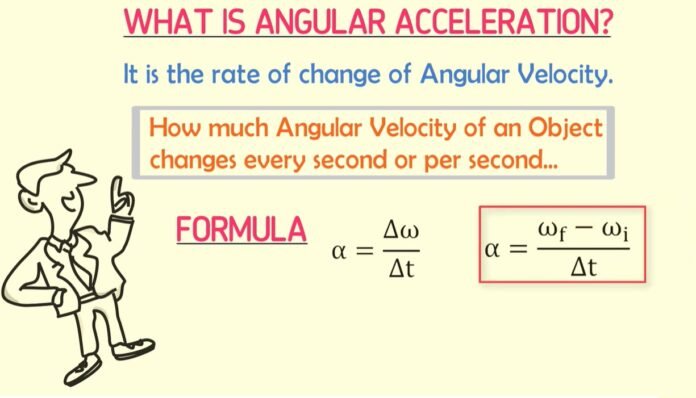Introduction
Angular acceleration is a physical concept that deals with the change in the rotational speed of an object. It is a measure of how quickly an object’s rotational speed changes.
It is also known as rotational acceleration and is denoted by the symbol alpha (α).
Angular acceleration is a crucial concept in physics and is applicable in various fields such as mechanics, engineering, and astronomy.
This article will delve deeper into the concept of angular acceleration, its formula, and its applications.
Definition of Angular Acceleration:
Angular acceleration is the rate at which an object’s angular velocity changes over time.
In simpler terms, it is the measure of how quickly an object is rotating or changing its rotational speed and can be both positive or negative, depending on whether the rotational speed is increasing or decreasing.
Angular acceleration can be negative when the angular velocity of an object is decreasing with time.
Difference between positive and negative angular acceleration-
Positive angular acceleration means that the angular velocity of an object is increasing with time, while negative angular acceleration means that the angular velocity of an object is decreasing with time.
The formula for Angular Acceleration:
The formula for angular acceleration is given as:
α = (ω2 – ω1) / (t2 – t1)
where,
α = angular acceleration (in radians/second²)
ω2 = final angular velocity (in radians/second)
ω1 = initial angular velocity (in radians/second)
t2 – t1 = change in time (in seconds)
The unit of angular acceleration-
The unit of angular acceleration is radians per second squared (rad/s2).
Understanding Angular Acceleration:
Angular acceleration is a vector quantity, which means it has both magnitude and direction. The direction of the angular acceleration is the same as the direction of the net torque acting on the object.
Torque is the force that causes an object to rotate, and it is directly proportional to the object’s moment of inertia and angular acceleration.
Suppose a force F is applied to a rigid body of mass m and moment of inertia I about its axis of rotation. The net torque acting on the object is given by:
τ = Iα
where,
τ = net torque (in Nm)
I = moment of inertia (in kgm²)
α = angular acceleration (in radians/second²)
From the above formula, we can see that the greater the moment of inertia, the greater the torque required to produce a given angular acceleration.
The relationship between angular acceleration and torque-
The angular acceleration of an object is directly proportional to the torque acting on it.
The relationship is given as α = τ/I, where
α is the angular acceleration,
τ is the torque, and
I is the moment of inertia.
Applications of Angular Acceleration:
Angular acceleration has many practical applications in various fields. Some of its applications are as follows:
- Motion of planets:
Angular acceleration plays a crucial role in the motion of planets around the sun. The gravitational force acting on the planets causes them to rotate around the sun, and the angular acceleration determines their speed and direction of rotation.
- Gyroscopes:
Gyroscopes use the principle of angular acceleration to maintain their orientation. They are used in airplanes, spacecraft, and ships to measure angular velocity and provide stability.
- Sports:
Angular acceleration is essential in sports such as gymnastics, diving, and figure skating, where athletes need to perform rotations and twists. Understanding angular acceleration helps athletes to control their movements and maintain their balance.
Some real-life examples of angular acceleration:
Some examples of angular acceleration in real life include the spinning of a top, the rotation of a wheel, and the motion of a pendulum. It is also seen in sports, such as when a gymnast performs a spin or a figure skater performs a spin on the ice.
Factors affecting Angular Acceleration:
Several factors can affect the angular acceleration of an object.
Some of these factors are as follows:
- Moment of Inertia: The moment of inertia is a measure of an object’s resistance to rotational motion. Objects with higher moments of inertia require more torque to produce the same angular acceleration.
- Net Torque: The net torque acting on an object determines its angular acceleration. A larger net torque produces a greater angular acceleration.
- Mass distribution: The distribution of mass in an object affects its moment of inertia, which, in turn, affects its angular acceleration. Objects with most of their mass concentrated at the edges have a higher moment of inertia and, therefore, require more torque to rotate.
Recommended Articles:
Anemometer – Types and Practical Applications
Anatomy of Human Ear
Amplitude Frequency Period Sound
Ampere’s Law | Definition, Application & Examples
Ampere: The Basics of Electrical Currents
The formula for angular acceleration is given as α = (Δω/Δt), where α is the angular acceleration, Δω is the change in angular velocity, and Δt is the change in time. Angular acceleration is the rate at which the angular velocity of a rotating object changes, whereas linear acceleration is the rate at which the velocity of a moving object changes. Angular acceleration is measured in radians per second squared, while linear acceleration is measured in meters per second squared. The moment of inertia is a measure of an object's resistance to rotational motion. It is the sum of the products of the mass of each particle in the object and the square of its distance from the axis of rotation. The angular acceleration is inversely proportional to the radius of rotation. This means that a smaller radius of rotation will result in a greater angular acceleration for the same torque.Angular Acceleration FAQs
What is the formula for angular acceleration?
What is the difference between angular acceleration and linear acceleration?
What is the moment of inertia?
How is angular acceleration related to the radius of rotation?
